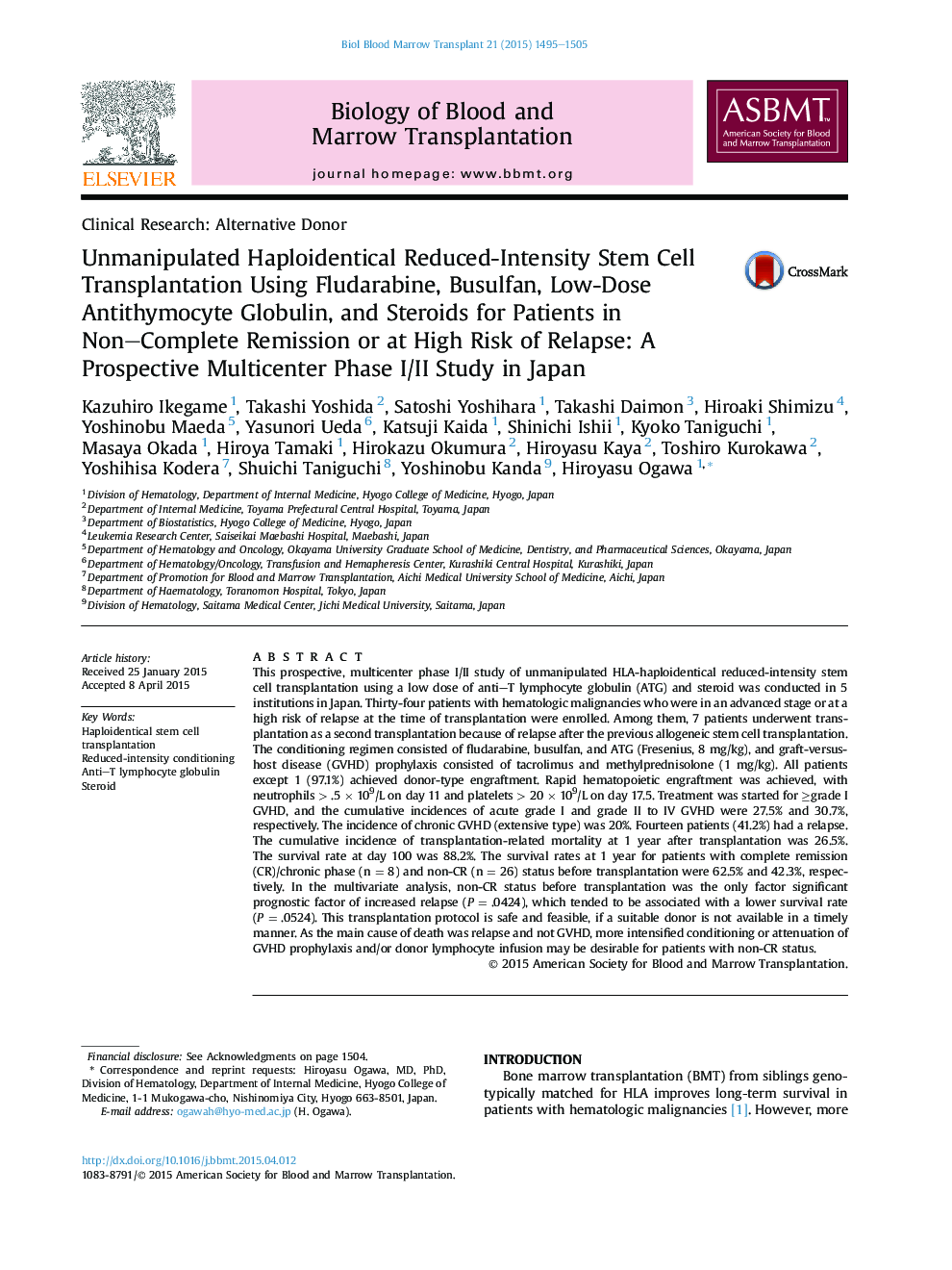| کد مقاله | کد نشریه | سال انتشار | مقاله انگلیسی | نسخه تمام متن |
|---|---|---|---|---|
| 8431374 | 1546264 | 2015 | 11 صفحه PDF | دانلود رایگان |
عنوان انگلیسی مقاله ISI
Unmanipulated Haploidentical Reduced-Intensity Stem Cell Transplantation Using Fludarabine, Busulfan, Low-Dose Antithymocyte Globulin, and Steroids for Patients in Non-Complete Remission or at High Risk of Relapse: A Prospective Multicenter Phase I/II Stu
دانلود مقاله + سفارش ترجمه
دانلود مقاله ISI انگلیسی
رایگان برای ایرانیان
کلمات کلیدی
موضوعات مرتبط
علوم زیستی و بیوفناوری
بیوشیمی، ژنتیک و زیست شناسی مولکولی
تحقیقات سرطان
پیش نمایش صفحه اول مقاله

چکیده انگلیسی
This prospective, multicenter phase I/II study of unmanipulated HLA-haploidentical reduced-intensity stem cell transplantation using a low dose of anti-T lymphocyte globulin (ATG) and steroid was conducted in 5 institutions in Japan. Thirty-four patients with hematologic malignancies who were in an advanced stage or at a high risk of relapse at the time of transplantation were enrolled. Among them, 7 patients underwent transplantation as a second transplantation because of relapse after the previous allogeneic stem cell transplantation. The conditioning regimen consisted of fludarabine, busulfan, and ATG (Fresenius, 8 mg/kg), and graft-versus-host disease (GVHD) prophylaxis consisted of tacrolimus and methylprednisolone (1 mg/kg). All patients except 1 (97.1%) achieved donor-type engraftment. Rapid hematopoietic engraftment was achieved, with neutrophils > .5 à 109/L on day 11 and platelets > 20 à 109/L on day 17.5. Treatment was started for â¥grade I GVHD, and the cumulative incidences of acute grade I and grade II to IV GVHD were 27.5% and 30.7%, respectively. The incidence of chronic GVHD (extensive type) was 20%. Fourteen patients (41.2%) had a relapse. The cumulative incidence of transplantation-related mortality at 1 year after transplantation was 26.5%. The survival rate at day 100 was 88.2%. The survival rates at 1 year for patients with complete remission (CR)/chronic phase (n = 8) and non-CR (n = 26) status before transplantation were 62.5% and 42.3%, respectively. In the multivariate analysis, non-CR status before transplantation was the only factor significant prognostic factor of increased relapse (P = .0424), which tended to be associated with a lower survival rate (P = .0524). This transplantation protocol is safe and feasible, if a suitable donor is not available in a timely manner. As the main cause of death was relapse and not GVHD, more intensified conditioning or attenuation of GVHD prophylaxis and/or donor lymphocyte infusion may be desirable for patients with non-CR status.
ناشر
Database: Elsevier - ScienceDirect (ساینس دایرکت)
Journal: Biology of Blood and Marrow Transplantation - Volume 21, Issue 8, August 2015, Pages 1495-1505
Journal: Biology of Blood and Marrow Transplantation - Volume 21, Issue 8, August 2015, Pages 1495-1505
نویسندگان
Kazuhiro Ikegame, Takashi Yoshida, Satoshi Yoshihara, Takashi Daimon, Hiroaki Shimizu, Yoshinobu Maeda, Yasunori Ueda, Katsuji Kaida, Shinichi Ishii, Kyoko Taniguchi, Masaya Okada, Hiroya Tamaki, Hirokazu Okumura, Hiroyasu Kaya, Toshiro Kurokawa,